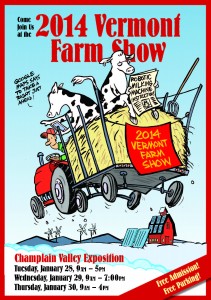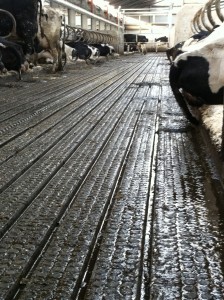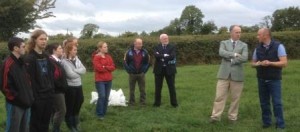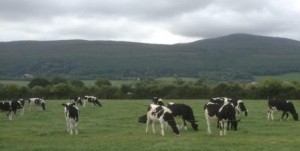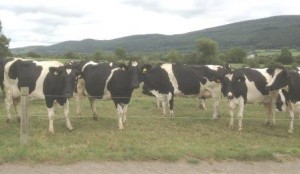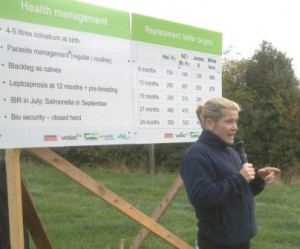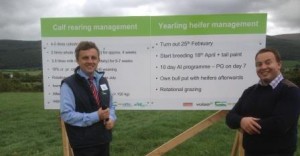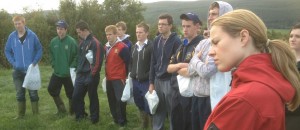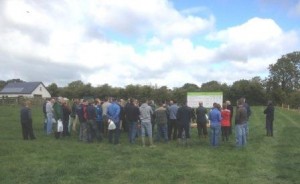UVM Extension Crop Insurance specialist Pam Smith has just posted a sheet with key crop insurance dates for 2014. Click this link below to see details on a variety of crop and revenue insurance programs and the sign up deadlines for each:
2014 Vermont Farm Show Coming
Problems with Employee Housing
Here is a question that we received this week, “….I am a farm owner and I have employees that live in housing on the farm. What are my rights or responsibilities if I decide to terminate the employee or terminate the housing agreement? Since the housing is linked to employment is this different than a standard renter/landlord situation?”
There are a variety of things to consider when setting up a housing agreement with a farm employee. There are also a number of laws that needs to be considered. In 2010 the VT Legislature passed Act 89 “An Act Relating to the Termination of Occupancy of Farm Employee Housing”. Click Here to read Act 89: ACT089_VT Statute
UVM Extension Farming Across Cultures Program has also posted this resource sheet that describes the specific steps a farm owner/landlord can take if employment or housing arrangements are to be terminated. Click this link to their: http://www.uvm.edu/extension/agriculture/faccp/files/aglabor_housing/farm_housing_statute.pdf
Farm owners can also contact the VT Department of Housing and Community Development to find resources for landlords. Click here for their website: http://accd.vermont.gov/strong_communities/housing/housing_resources/rental
Afforable Care Act: Essential Info for Farm Employers
Despite the lack of clarity and challenges of the new national Affordable Care Act, farm employers must prepare to set up the appropriate health care options for their employees (or make the accurate determination that no plans will be offered).
Farm Credit East just posted a detailed webinar: (click below to link to webinar)
The Affordable Care Act:What Farmers Need to Know
Farm owners and farm business advisers should review this material and plan to keep up with current news to determine if and how they need to provide coverage for employees. * It is important to research the specific policies in each state. For example, the State of Vermont law only provides an exemption for 4 or less employees. That is very different than the federal exemption of 50 or less employees. Farms in VT whose employee base meets the criteria of 5 or more full time employees may be required to provide health care or to pay a penalty if care is not provided.
Vermont farm owners can research their particular situation at VT Health Connect: Small Business Resources
Farm Employer Fact Sheet Posted
We have just posted a Farm Employer Fact Sheet to our Resource Library.
[We have just updated the sheet. We found an error relating to the VT laws related to the new Affordable Care Act]
Are you in compliance with labor laws? Do you know who to contact if you have questions? This general overview explains the basic steps to getting a employee set up, basic workers compensation issues, Affordable Care Act updates and key agency resources to contact for more information.
Check it out the, click here: Farm Employer Overview
Will Irish Grass-Based Beef Imports Swallow up the Niche?
What do we think will happen to beef markets? Traditionally we have had smaller producers in VT that often have higher costs of production, processing and distribution. But we have also seen a good deal of innovation in rotational grazing and grass-based beef producers that are able to target customers seeking the various attributes of a grass-based meat. But we can’t lose sight of our competition. Ireland has excelled at all forms of grass based farming, including dairy and beef.Grass-finished beef is the commodity beef in Ireland, it’s the norm.
Check out this article about Irish beef setting their sights on US markets
Check out these programs, something for everyone
As winter approaches UVM Extension Farm Viability has been lining up a number of business program options to meet the diverse needs of farms in VT. Here is a quick list of current events and programs. Contact us to register for one that will advance your business planning today! Subscribe to the blog for occasional updates (over on the right) and forward this link to your farming friends that have never worked with Farm Viability.
Management Mondays: 20-30 minute webinars covering hot topics in farm business (click this link for the schedule)
Maple Business Benchmark: this new program will work one-on-one with maple producers to evaluate the financial performance for their business. As numbers grow in the program we will publish overviews of financial performance at different scales of production. (click here to learn more)
Full Business Plans, Cash Flow Analysis, Enterprise Analysis and Dairy Management Teams. This has been our core program for over 10 years. Go to the “Programs for Farmers” to see a summary of these options or click this link for an application
New farm transfer planning guidelines on the way! We are working with the statewide Farm Viability Program to make sure transfer planning can support all the unique family and non-family transfer scenarios we see on Vermont farms today.
Our resource library continues to grow with additions of fact sheets and financial templates to assist farm managers. Click here to browse the Resource Library
Northern Ireland: State of the Art Demonstration Greenmount
Today we spent the day visiting with “technologists” and seeing their state of the art demonstration farm at the Greenmount Campus. College of Agriculture, Farms and Rural Enterprise (CAFRE) at Greenmount provides various levels of vocational, technical and advanced agriculture degree programs in Northern Ireland. http://www.cafre.ac.uk/index.htmThey have just completed work on a nee dairy demonstration facility. The 150 cow herd has moved off grazing land and into the barn for the winter season. The facility features padded floors at key spots, robotic alley cleaners and an innovative manure/urine separator floor (see image below). The floor scraper separates urine and manure to reduce the mixing that promotes ammonia volatilization. They expect this is several years ahead of an industry that is soon approaching numerous innovations to reduce greenhouse gas emissions on farms.
On the greener side, we saw horticulture demonstrations, testing numerous late season and winter ornamental crops that could add off season cash flow to nursery and greenhouses. It is not uncommon here for a live
stock farm to also manage an ornamental hoop house for another source of income. Crops include: ornamental cabbage, winter rose and cyclamen(see below)
Markup and Margins: Price Setting Essentials
Understanding price-setting is essential for anyone who produces, buys or sells agricultural products. UVM Extension Farm Viability has just posted a resource sheet that explains how “markups” and “margins” are applied to prices. The “Mark-up and Margins to Set Prices” sheet also provides tables to convert product prices based on common markups and margins we observe in the market place today.
You can view or download the “Mark-up and Margins to set Prices” fact sheet today. Click this link to the Resource Library page and scroll down to find this fact sheet and other resources for farm businesses. http://blog.uvm.edu/farmvia/?page_id=26
Ireland today September 29, 2013
Jim and Teresa White know how to raise heifers. They just won the National Heifer Rearing Competitionhere in Ireland. There was a farm walk at their farm in County Tipperary on the 10th of September.
What is unusual about the White’s farm is not that they weigh calves and heifers 4 or 5 times per year. What is unusual is that then they do something about it! They remove the quarter of the animals that are the smallest and put them into their own group. These heifers get special treatment: extra feed and the freshest paddocks.
Jim and his wife have a milking herd of 106 cows, mostly Friesian, with some Jersey crosses. They produce spring milk, so their herd is dried off for about 6 weeks, starting in December. One of their big goals is ‘compact calving.’ They are able to have 78% of their herd freshen within 6 weeks, starting on January 14. In order to do this, they must really concentrate on breeding cows within a short period of time. Cows that do not fit the calendar are culled. (These might be great cows for someone else’s dairy herd). They also select bulls with shorter gestation periods.
Calves get a good start: they are offered 3 quarts of colostrum within the first hour of birth, the first half hour is their goal, and the calves usually drink 2 quarts or a little more. Then Jim and Teresa continue to take top care of them. Calves are weaned when they are double their birth weight. The goal is to have the heifers at 60% of their mature weight by 13-14 months to begin breeding so they freshen at 24 months of age.
The Whites have an interesting system. They are milking 106 cows now. But 139 cows and heifers calved this spring and they had 141 calves born. There were 56 heifers and 58 calves on the farm on the day of the farm walk. All male calves are sold at about 2 weeks of age, and fresh cows that might not quite fit his breeding program or that have some kind of a problem are culled. Their goal is to be milking about 150 in 2015, and then raise just enough calves to keep the herd size stable. They focus on keeping the earliest born calves, with the best genetics, that come from easy-breeding cows for the herd. And because they have a good herd, other dairy farmers are quite interested in buying dairy cattle from this farm.
The Whites attention to detail and is what earned them the Heifer Rearing award. Feeding colostrum, a vaccination plan, weighing heifers to sort and group them, keeping heifers growing, breeding them to freshen at 24 months, and compact breeding and calving were the main points stressed at the farm walk.
The last ‘stand’ at the farm walk was an opportunity to talk about fodder (forage) budgeting with farmers. According to a survey done in early September by Teagasc, about 20% of the farms in Ireland are short of hay or silage. Results further showed the country to be about 8% short. Teagasc advisors are recommending that farmers count and measure their forage supplies. Then calculate how many head are on the farm now, and are likely to be on the farm come spring. Farmers surveyed were counting on 140 day barn-feeding period, which seems like a bit of wishful thinking, as 150 days might be more like it (in Vermont it is more like 200 days). No matter how long the winter might be, the point is to do some figuring now in order to do some buying of feed or selling of animals. There is a good supply of straw from the wheat and barley crops that can be fed with haylage in a ration for tail enders and dry cows, in order to stretch the home-grown forage supply.

